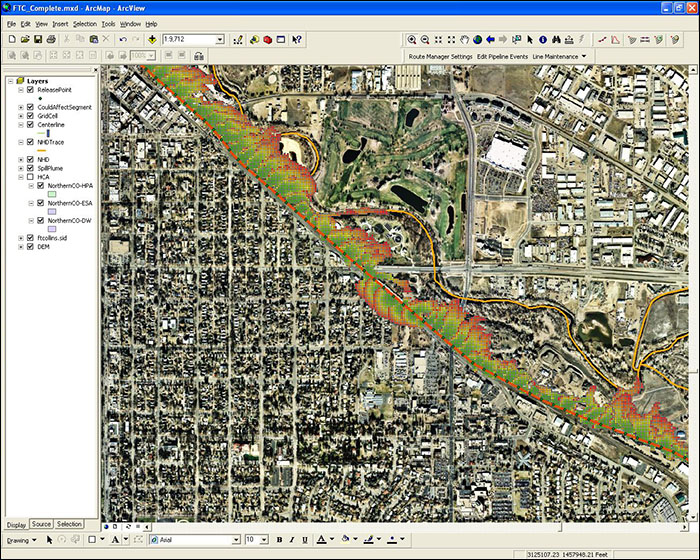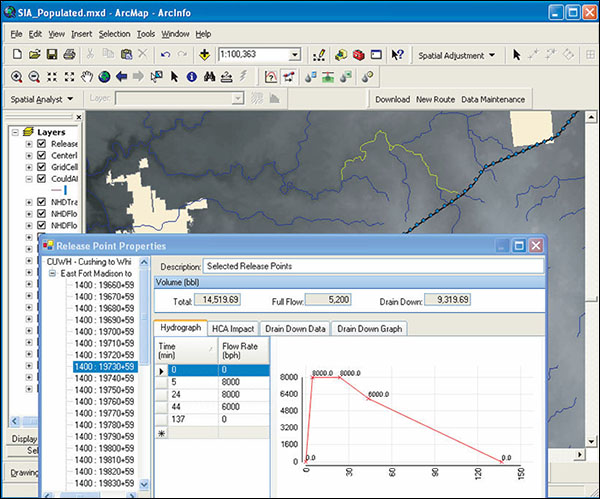Integrity Management
Evaluate pipeline risk and create accurate mitigation plans
Spill Impact Analyst provides invaluable assistance when developing highly accurate leak mitigation and response plans. With this accurate modeling, operators can create plans to effectively respond to leaks and remedy a situation in less time, with fewer environmental damages, and at an overall lower cost.
Using Spill Impact Analyst, operators can quickly evaluate the potential for pipeline leaks, predict worst-case release volumes, and create plans to mitigate the impact of those potential leaks. The output reporting is straight forward, designed so even casual users can understand the spread of the leak over a terrain and grasp where and how far it will travel.
This flexible Esri ArcGIS desktop extension uses the most advanced overland flow analysis engine available, FLO-2D, to realistically project the speed and spread of the spill over the surface. It also identifies the High Consequence Areas (HCAs) and stream channels that could be affected. This powerful analysis engine provides unmatched in-house capabilities and its advanced features can even calculate pool fire thermal radiation hazards around the resulting spill plume and display those results visually in ArcMap.
Request a Product Demo
Request DemoWatch the Product Video
WatchDownload Product Brochure
Download
- Ensure emergency preparedness by creating “what-if” scenarios and adjusting variables such as valve types, pipe segments, and depth of cover.
- Uses the FLO-2D model, which utilizes full dynamic wave momentum equations, resulting in a more realistic path of liquid over time.
- Provides user-friendly controls to calculate release points at distance intervals, specified locations, and National Hydrology Datasets (NHD) waterway intersections.
- Calculates release volume based on valve isolation points, line fill, depth of cover, valve closure time, response time, and flow rates to help you.
- Displays detailed analysis results as polygon spill plumes in ArcMap.
- Provides reporting & graphs including time-to-impact, impact volume, volume released from a pipeline during Full Flow (prior to shut down and isolation), Drain Down (after shutdown and isolation), and Total (combination of full flow and drain down) which is particularly useful in Emergency Flow Restriction Device (EFRD) analysis.
- Analyzes release points, system shut down time, valve closures, and flow.
- Predicts which stream channels will be affected through the use of channel flow modeling with the National Hydrography dataset.
- Lets you add, edit, and delete downloaded pipeline data.
- Drapes pipeline data over a Digital Elevation Model (DEM).
- Performs water transport trace analysis using USGS NHD and NHDPlus data.
- Supports standard NPMS layers and user defined HCAs.
- Uses a geodatabase datasets for NHD, DEM, and HCA data.
- Performs time-based analysis.
- Produces spill plumes, water transport vectors, could-affect segments, and not-affect segments, all stored in a personal geodatabase.
- Categorizes liquid HCA “Could-Affect” segments by HCA input type.
- Produces pipeline drain-down plot.
- ArcGIS Desktop
- Oracle, SQL Server, Access
- Windows 7 or Windows 10
- Microsoft .NET Framework
SPILL IMPACT ANALYST is a trademark or registered trademark of New Century Software, Inc. Third party trademarks, trade names, product names and logos may be the trademarks or registered trademarks of their respective owners.



